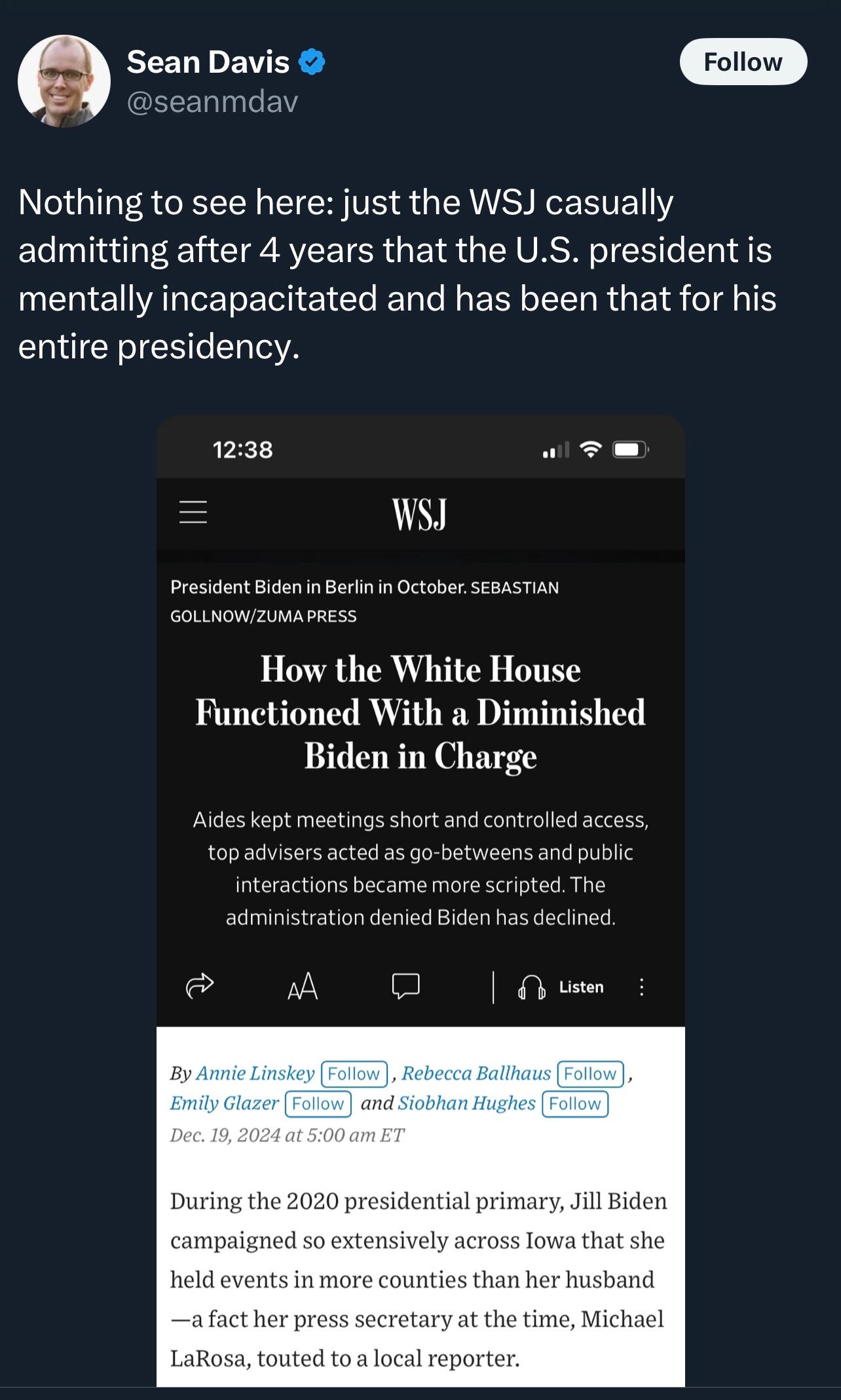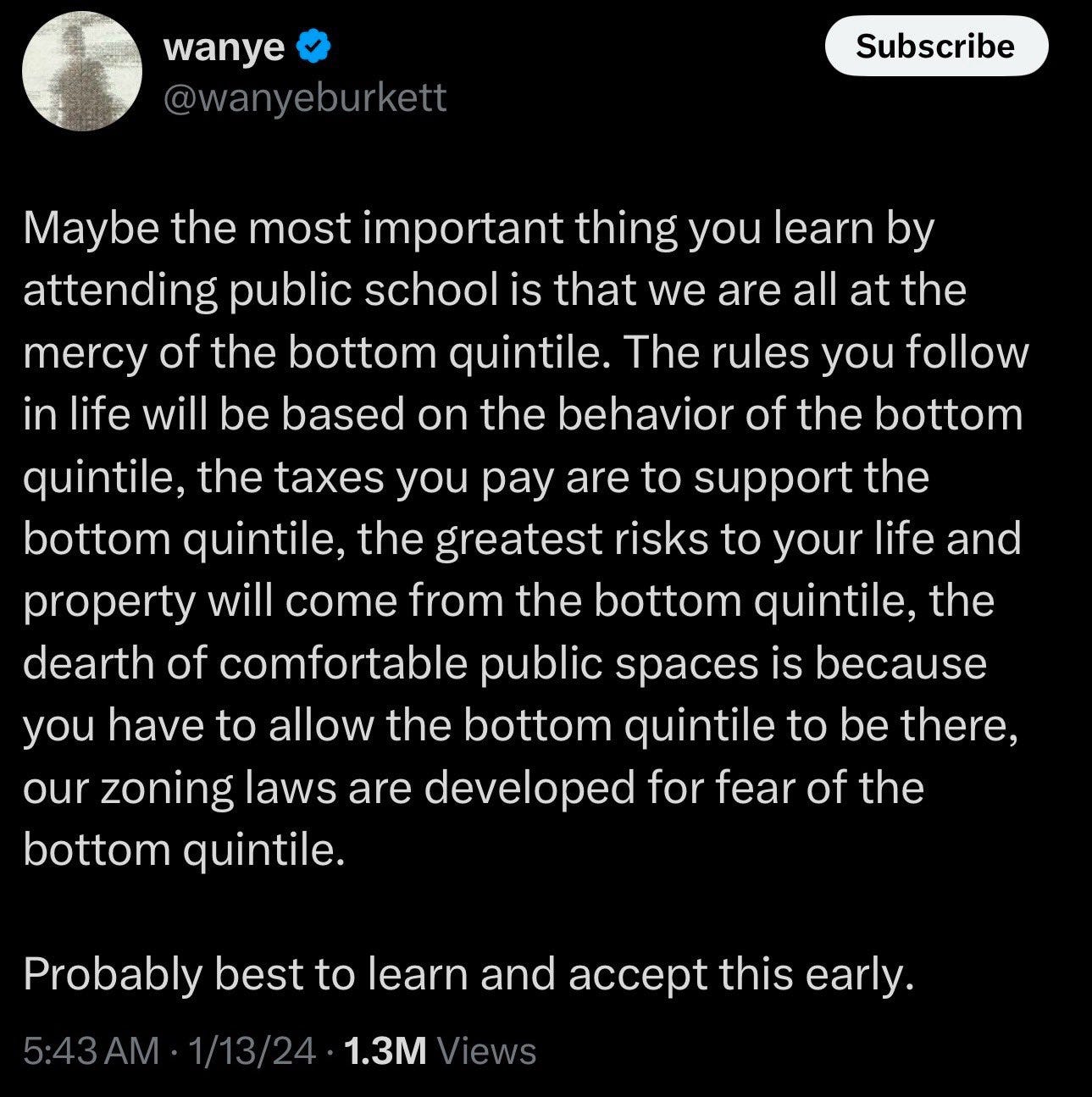Full holiday wind down mode here so will be uncharacteristically brief. Traveling starting tomorrow through the New Year and may even decide to take a Bye Week next week post-Xmas depending on my wi-fi access and appetite for destruction.
Regardless, we’re still in limbo until January 20th so unless Biden’s puppetmasters resume their Bataan Death March towards World War 3 or the alien drone likely hoax kicks into full overdrive, most of what we’re seeing is just noise and pre-skirmishes before the battle begins in earnest after the Inauguration.
Time to decompress with the family for the next week or so and take stock of 2024. All-in it was an extraordinarily difficult year for me, both from a professional and personal viewpoint. Grateful it’s ending on a high note. Here’s what my email auto-reply will look like for the next 10 days. I encourage you to do the same if able.
DEBT CEILING & CONTINUING RESOLUTION BILL DRAMA
So tense, so dramatic! Well, not really. Only if this is your first time touring Washington, D.C., and the gilded halls of venality and Sturm und Drang. For those paying attention, this is just another chapter in Washington’s most reliable export: Kayfabe.
What’s Kayfabe, you ask?
Kayfabe is a term born in the gritty, sweat-soaked world of professional wrestling. It’s the art of making scripted feuds, rivalries, and outcomes feel real, the illusion that the battle is authentic, the stakes existential. Fans eat it up, investing emotionally in the drama while the wrestlers and promoters laugh backstage, splitting the spoils. Washington’s version is eerily similar—except instead of body slams, you get debt ceilings; instead of steel cages, you get late-night committee hearings.
This week’s so-called budget "showdown" played out like a well-rehearsed act from this circus of political theater. So what’s the reality? We’ve gone so far off the rails that these semi-quarterly government shutdown "crises" have become routine—a tragicomedy of performative governance. Yes, in the past, such battles carried real stakes. But now? The White House holds the executive branch, both chambers lean predictably, and the opposition party is a hollowed-out shell nursing its propaganda arm’s wounds. The only thing missing was a folding chair to the face.
In days gone by, they would have rammed this spending bill down our throats, grinning ear to ear as they funded pet projects under the banner of "keeping the government open." This week’s clash was just a prologue—a sparring session. A skirmish to probe defenses before mobilizing the main forces. The real battle is still to come.
And here’s the kicker: default mode for MAGA Republicans and anyone serious about reform should be pure blitzkrieg. Aggression isn’t just a strategy; it’s a survival mechanism. The entrenched power structure—a Leviathan of insider deals, kompromat, and mainstream media spin—thrives on inertia. It will resist every step toward meaningful reform with the kind of histrionic theatrics you’ve come to expect: "They canceled funding for kids with cancer!"
The sad truth is, blackmail material or kompromat likely exists on enough Republicans (and the rare sane Democrat) to push some over the edge, siding with the opposition to delay, frustrate, or outright sabotage the moves Trump, Elon, Vivek, and Team America First are trying to execute. That’s why the playbook can’t just be reformist; it has to be revolutionary.
Executive Orders? Use them. Fire the bottom 20% of federal employees as a start—the ones who sleepwalk through their shifts, adding no value but plenty of cost. The real number is closer to 80%, but we’ll probably have to ‘boil the frog’ and do 20% a year just like they’ve boiled the frog step by step and whittled away your civil liberties and any semblance of fiscal sanity over the last three decades. What they’ve done incrementally, we should counter with bold, unapologetic action.
When legislation and budget discipline fall short, go nuclear—legally, of course. Biden and Obama showed the way by dismantling the border wall and using executive tools to bypass Congress. It’s time to return the favor, not out of spite but necessity. Winning isn’t enough. Dismantling the apparatus—the anti-human, anti-American corruption engine—is the only way forward.
And that requires transparency. Brutal, merciless, forensic transparency. Lay bare the surveillance state that spied on its own citizens. Expose the shredding of the social compact during COVID. Dissect the four years of gaslighting about a fictional, deranged president—a man vilified for working against entrenched interests while his opponents cashed in on influence-peddling schemes with the world’s worst actors.
Judgment Day is overdue. Not just for the figureheads but for the entire swampy ecosystem that sustains them. Call it what you will—a reckoning, a purge, or Zero Dark Thirty for the bureaucracy. But know this: we’re not fighting for a win. We’re fighting for the survival of the Republic, for a future where government serves the people, not the insiders.
Because Kayfabe might make for great entertainment, but it’s a disastrous way to run a nation.
Media & Bill Decoder
I’ve written time and again about the paradigmatic tsunami that is AI—a transformative tidal wave sweeping through our society with an unstoppable trajectory. Like distant ripples on the open ocean, the signs of its arrival are already visible. But as this wave builds and crashes onto the societal shore, few seem prepared for its full impact. Yes, there will be massive disruption—labor markets reeling, societal structures wobbling—but there will also be profound positives waiting to be unlocked for those with the vision to seize them.
Enter Grok, Elon Musk’s AI engine, powered by X and vast GPU clusters. This technological marvel is already capable of feats once thought impossible: digesting a 1,500-page Continuing Resolution bill and delivering a hyper-concise, targeted analysis of its contents. The implications are revolutionary. The days of Congressional staffers dumping a doorstop-sized bill on the desks of Congress and the President—giving them 24 hours to vote or sign—are coming to an end. No more hiding the pork and bribes in plain sight, no more exploiting the ignorance of lawmakers who barely skim the executive summary, let alone the fine print.
Take the latest farce as an example: Vivek Ramaswamy, likely the only man in America with the stamina and intellect to actually read the entire 1,500-page bill. It shouldn’t require a 160 IQ and a sleepless night to figure out what you’re voting on. Legislation like this should be debated, dissected, and stripped of unnecessary pork over weeks, not rammed through under the pretense of urgency. The absurdity of burying billions of dollars in unrelated, wasteful spending—all in the guise of a Continuing Resolution—should insult anyone who values transparency and governance.
The recent border funding debacle is another case in point. Earlier this year, a weak, toothless border bill was cynically stapled to Ukraine spending. Why? To force an all-or-nothing vote, leveraging geopolitical urgency to smuggle through domestic incompetence. Important spending topics deserve their own spotlight. Straight up-or-down votes. No gimmicks. Every Congressman—yea or nay, on the record.
Fortunately, AI is cutting through the fog. Tools like Grok can analyze a bloated bill in seconds, flagging the detritus that lawmakers hope no one will notice. No longer can bureaucrats and lobbyists rely on obfuscation and last-minute theatrics to slip in their pet projects. The garbage gets exposed—instantly.
But Grok isn’t just a watchdog for the legislative process. It’s also poised to revolutionize how we consume and trust media. These same AI platforms now dissect media publications for partisan bias, exposing the ideological games played by outlets like Bloomberg, The New York Times, and The Washington Post. The era of Fake News—hyper-partisan opinion pieces disguised as journalism, outright falsehoods presented as fact—is being reined in. When AI can systematically identify and highlight bias, the credibility crisis in media becomes impossible to ignore.
The rise of AI isn’t just a wave—it’s a reckoning. It’s the beginning of a new era where manipulation, deceit, and inefficiency are no longer the unchallenged norms. If wielded wisely, AI is more than a disruptor; it’s the scalpel that slices through the diseased tissues of modern governance and media, leaving behind a cleaner, leaner, more transparent system. Let’s hope we’re ready to ride this wave—not drown in it.
Here’s a bit on Grok’s new ‘Media Decoder’ from Grok itself:
The Media Decoder, as mentioned in recent updates from X, is a feature designed to analyze articles for bias. Here's a detailed breakdown of what this tool might offer:
Purpose:
Bias Detection: The primary function is to identify and highlight biases within news articles, opinion pieces, or any textual content. This includes political, cultural, or commercial biases that might skew the narrative presented.
How It Works:
Text Analysis: The Media Decoder likely uses advanced natural language processing (NLP) and machine learning algorithms to scrutinize the language, tone, word choice, and structure of an article to detect bias.
Source Evaluation: It might also consider the source's historical reporting patterns, ownership, funding, or known affiliations to assess potential bias.
Contextual Analysis: Beyond just the text, it could evaluate the context in which the article was written, including timing (e.g., during elections or crises), and compare it with other coverage on similar topics.
Features:
Bias Score: Articles might receive a score or rating indicating the level of bias detected, possibly on a spectrum from unbiased to highly biased.
Highlighting: Specific phrases or sections might be highlighted where bias is detected, helping users understand where and how the narrative might be influenced.
Explanation: An explanation or a summary might be provided, detailing why certain parts of the content were flagged, perhaps with examples or comparisons to more neutral coverage.
Alternative Perspectives: The tool could suggest other articles or sources that provide differing views or more balanced reporting on the same topic.
Benefits:
Enhanced Critical Thinking: Encourages readers to think critically about what they read, understanding that all media can contain some level of bias.
Transparency: Promotes transparency in media consumption, allowing users to make more informed judgments about the information they consume.
Education: Acts as an educational tool for understanding media literacy, particularly how news can be framed or manipulated.
Potential Challenges:
Accuracy: The accuracy of bias detection depends heavily on the algorithms' training and the data they're based on. Misjudgments can occur.
Subjectivity: What constitutes "bias" can be subjective; different users might interpret the same analysis differently.
Manipulation Concerns: There's a risk that the tool itself could be seen as biased if it's perceived to favor one type of narrative over another.
This feature represents a step towards more transparent and nuanced media consumption, though it must be used with an understanding of its limitations and in conjunction with one's own critical thinking skills.
Fani Willis Gets Das Boot
Now that the Regime’s stranglehold on the nation and media is fading, the consequences are beginning to unfold. Case in point: Fani Willis being removed from Trump’s RICO case in Georgia.
From day one, it was obvious this case wasn’t about justice—it was about raw, unrestrained political vengeance. And now, the Georgia appellate court has delivered a resounding verdict: Fani Willis is out. Why? Because the entire operation was riddled with corruption and conflicts of interest, exposing it for what it truly was—a partisan hit job, cloaked in the veneer of legality, and weaponized against Donald Trump.
This was never about upholding the rule of law. It was about bending it to serve a political agenda, funded and orchestrated by the establishment elites who couldn’t defeat Trump on the debate stage or at the ballot box. So, they resorted to lawfare—unconstitutional, unethical, and blatantly desperate.
But here’s the thing: the American people aren’t blind. They’ve seen through this charade from the start. Today’s decision isn’t just a win for Trump; it’s a win for anyone who values fairness and justice over the cynical, self-serving machinations of the ruling class.
The playbook is crumbling, and the cracks in their narrative are growing too large to patch. The establishment tried to crush a movement, but instead, they’ve exposed their own rot. Justice may take its time, but it always finds a way to prevail. Watch closely—this isn’t just a moment; it’s a confirmation that November 3rd was a critical turning point.
Removal of Fani from the case should be the first blow for this corrupt, race-baiting criminal. Disbarment and prosecution for honest services fraud should be on deck…
What I’m Watching and Reading….
In light of the article above and the jaw-dropping advances in the new o3 OpenAI model, here’s Sam Altman’s essay on The Intelligence Age.
Bit off the beaten path, but this is a podcast that caught my interest.
Here’s a trailer for the film.
Best of Twitter
Memetic Warfare
Parting Words…
That’s it for this week folks! Hope you enjoyed. Have a very merry Christmas, a happy Hanukkah and whatever else you celebrate, enjoy it! We’re blessed to be here. -MK
























































Merry Christmas. Thanks for a great year of substacks